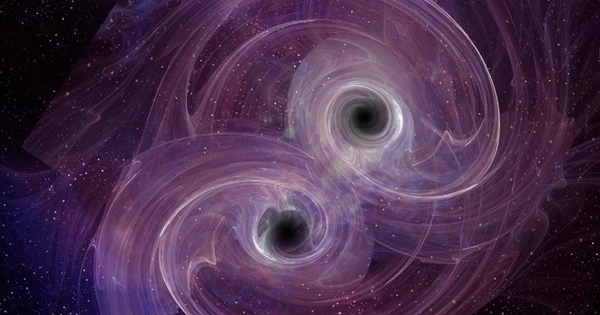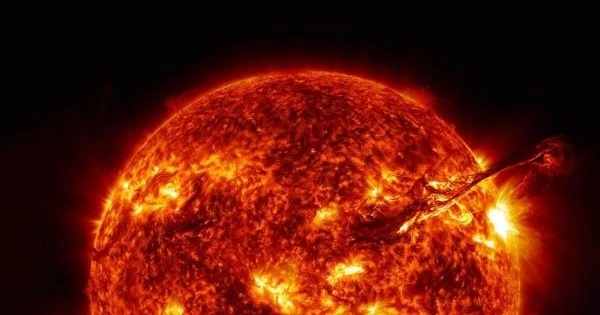A gravitational wave travels through spacetime on a route known as a null geodesic. This is the path that a light ray traveling in the same direction would take, and gravitational waves are influenced by black holes in the same manner that light rays are. Gravitational waves, for example, can be refracted by gravitational lenses in the same way that light waves are. If a gravitational wave enters the event horizon around a black hole, it is condemned to journey inwards to the singularity and will never escape.
Our cosmos is a chaotic sea of space-time ripples known as gravitational waves. Astronomers think waves from orbiting pairs of supermassive black holes in distant galaxies are light-years long and have been trying to observe them for decades, and now they’re one step closer thanks to NASA’s Fermi Gamma-ray Space Telescope.
Fermi detects gamma rays, the most energetic type of light. A worldwide team of scientists reviewed Fermi data acquired from pulsars, the rapidly revolving cores of stars that erupted as supernovae, for almost a decade. They looked for small differences in the arrival timing of gamma rays from these pulsars, which could have been generated by the light travelling through gravitational waves on its route to Earth. They didn’t discover any, however.
We kind of surprised ourselves when we discovered Fermi could help us hunt for long gravitational waves. It’s new to the fray — radio studies have been doing similar searches for years. But Fermi and gamma rays have some special characteristics that together make them a very powerful tool in this investigation.
Matthew Kerr
While no waves were observed, the research indicates that these waves may be within Fermi’s reach with more observations.
“We kind of surprised ourselves when we discovered Fermi could help us hunt for long gravitational waves,” said Matthew Kerr, a research physicist at the U.S. Naval Research Laboratory in Washington. “It’s new to the fray — radio studies have been doing similar searches for years. But Fermi and gamma rays have some special characteristics that together make them a very powerful tool in this investigation.”
The results of the study, co-led by Kerr and Aditya Parthasarathy, a researcher at the Max Planck Institute for Radio Astronomy in Bonn, Germany, were published online by the journal Science.
Gravitational waves traveling at light speed are produced when big objects accelerate. The ground-based Laser Interferometer Gravity Wave Observatory, which detected gravitational waves for the first time in 2015, can detect ripples tens to hundreds of miles long from crest to crest that pass Earth in fractions of a second. The Laser Interferometer Space Antenna, which will be launched into space, will detect waves that are millions to billions of miles long.
Kerr and his colleagues are looking for light-years, or trillions of miles, vast waves that take years to pass Earth. These long ripples are part of the gravitational wave background, which is a random sea of waves created in part by pairs of supermassive black holes in the nuclei of merging galaxies around the universe.

Scientists require galaxy-sized detectors known as pulsar timing arrays to find them. These arrays make advantage of certain sets of millisecond pulsars, which spin as quickly as blender blades. Millisecond pulsars sweep radiation beams, ranging from radio waves to gamma rays, through our line of sight, appearing to pulse with amazing regularity – like cosmic clocks.
Long gravitational waves that pass between one of these pulsars and Earth delay or advance the arrival time of light by billionths of a second. Scientists hope to discover gravity waves passing through an array of pulsars by looking for a certain pattern of pulse changes.
Radio astronomers have been employing pulsar timing arrays for decades, and their measurements are the most sensitive to gravitational waves. However, interstellar impacts make radio data analysis more difficult. Space is strewn with stray electrons. Their combined actions modify the path of radio waves over light-years. These changes the arrival times of pulses at different frequencies. Gamma rays are immune to these difficulties, serving as both a supplemental probe and an independent validation of radio results.
“The Fermi results are already 30% as good as the radio pulsar timing arrays when it comes to potentially detecting the gravitational wave background,” Parthasarathy said. “With another five years of pulsar data collection and analysis, it’ll be equally capable with the added bonus of not having to worry about all those stray electrons.”
Both radio and gamma-ray astronomers aim to reach sensitivities that will allow them to detect gravitational waves from circling pairs of giant black holes within the next decade.
“Fermi’s remarkable capacity to precisely time the arrival of gamma rays and its vast range of view enable this measurement,” said Judith Racusin, Fermi deputy project scientist at NASA’s Goddard Space Flight Center in Greenbelt, Maryland. “Since its launch, the mission has continuously astonished us with new knowledge about the gamma-ray sky. We’re all looking forward to the next fantastic discovery.”
















